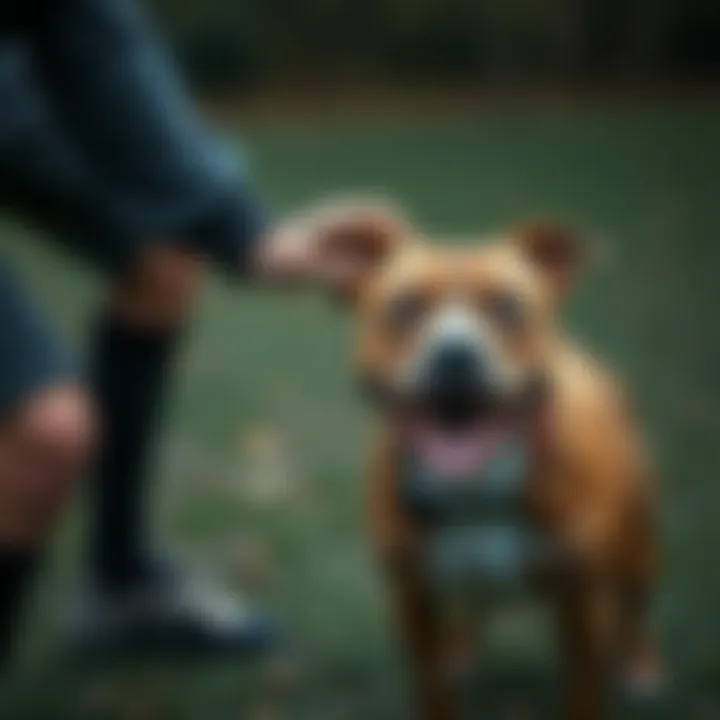Effective Strategies to Reduce Aggression in Pitbulls


Intro
Biting behavior in Pitbulls is a complex matter that stirs questions among pet owners and enthusiasts alike. It is often misunderstood, leading to staggering myths and stigma surrounding the breed. The core of the issue lies not just in aggression but, more importantly, in the need to decode the reasons behind such behavior.
Many attribute biting to inherent traits, overlooking the significant influence of environment, training, and social factors. This article sets out to sift through these layers, providing practical insights for those keen on nurturing a safe environment for both their Pitbulls and the people around them.
By exploring nutrition, behavior understanding, training techniques, and environment safety, we aim to equip you with the necessary tools to mitigate aggression. After all, every Pitbull has the potential to be a gentle companion given the right guidance and care.
Pet Care Essentials
When addressing aggression in Pitbulls, the first stop on our journey is understanding the basic needs of your pet. It’s essential to create a strong base through proper care, which encompasses daily nutrition, exercise, grooming, and overall wellness checks. These components act as building blocks, fostering not only a healthy body but also a stable mind.
Daily Nutrition Requirements
Feeding your Pitbull the right diet can do wonders for his behavior. A balanced diet rich in high-quality protein is crucial. Choosing foods that are high in omega-3 and omega-6 fatty acids can enhance brain function and mood regulation. Monitor food portions and be cautious with treats; too many can lead to obesity, which sometimes expresses itself through irritability.
Exercise and Playtime
Regular exercise cannot be overstated. Pitbulls are energetic dogs that thrive on physical activity. Daily walks, play sessions in the yard, or trips to a dog park can help burn off excess energy. Remember, a tired dog is a happy dog. Engaging in activities that challenge both their bodies and minds, like agility training, can enhance their focus and reduce aggressive tendencies.
Grooming Tips
Grooming may not directly curb biting, but it strengthens the bond between owner and pet, promoting trust. Regularly brushing your Pitbull will not only maintain a shiny coat but also keeps them accustomed to being handled. Incorporating tooth brushing into your routine is also a good idea, as dental discomfort may sometimes manifest as aggression.
Health and Wellness Check-ins
Frequent health check-ups can catch potential issues before they escalate. Keeping up with vaccinations and maintaining a relationship with a veterinarian can help identify health-related behaviors. If a Pitbull is in pain or discomfort, aggression may just be an expression of that.
Behavior & Training
Beyond basic care, understanding behavior is critical. Recognizing what your dog is trying to communicate can lead to significant breakthroughs in handling aggression. Knowing a few key techniques might make the journey smoother.
Understanding Your Pet's Body Language
Canines communicate largely through body language. Understanding signals like a tucked tail, raised hackles, or bared teeth can help you gauge your Pitbull’s emotions and reactions. Learning these cues can prevent situations from escalating, averting potential biting incidents.
Basic Training Techniques
Training serves as an essential tool in behavior modification. Establishing consistency and positive reinforcement can shift behavior significantly. Techniques like 'Sit,' 'Stay,' and 'Leave it' do more than just teach commands; they instill forms of self-control. A well-trained dog often feels more secure and less prone to reacting negatively.
Behavioral Concerns & Solutions
If aggression does surface, take note of what might have triggered it. Certain situations, like unexpected loud noises or unfamiliar visitors, can scare a Pitbull. Gradually exposing them to these stimulus—at their comfort level—can help reduce fear-based responses. Use gradual exposure techniques, rewarding calm behavior with treats.
Socialization Tips
Socializing your Pitbull early is one of the best defenses against aggression. Introduce them to other dogs and people in a controlled manner, observing for any signs of discomfort. Positive interactions can safely build their confidence around new experiences.
"Socialization isn't just a one-time event. It's a continuous process of exposure and trust-building for your Pitbull."
Pet Home Environment
Creating the right home environment is paramount in managing aggression. This includes both the physical space and the atmosphere created by interactions.
Creating a Pet-friendly Space
Ensure your home is safe and welcoming for your Pitbull. This means removing hazardous items like sharp objects, electrical cords, or toxic plants. Providing a designated area where your dog can retreat will help them feel secure.
Safety Measures and Hazards to Avoid
Avoid situations that can provoke aggressive behavior. Understand your Pitbull’s triggers, be it certain noises, or the presence of strangers. Identifying these elements can help you manage interactions more thoughtfully.
Choosing the Right Toys and Accessories
Toys that encourage healthy chewing can distract aggressive tendencies. Look for durable toys designed specifically for strong jaws. Similarly, a good harness can assist in better control during walks, enhancing your confidence while handling your pet.
Setting Up a Comfortable Resting Area
A cozy, quiet resting area is crucial. Having a personal space allows your Pitbull to recharge without disturbances. This simple step can drastically improve how they handle stressors, contributing to better overall behavior.
Pet Health Issues
Pets, like people, can face health hurdles that affect their temperament. Keeping an eye out for signs of illness allows you to react swiftly if changes in behavior arise.
Recognizing Signs of Illness
Changes in appetite, energy levels, or social willingness could point to underlying health issues. When a Pitbull is not feeling well, frustration or fear may lead to aggression.
Preventative Care Measures
Routine vaccinations, dental cleaning, and parasite preventatives keep your furry friend healthy and reduce anxiety from illness.
Common Ailments and Treatments
Some common health issues in Pitbulls include skin allergies, hip dysplasia, or ear infections. Recognizing the symptoms early can guide appropriate treatments, keeping aggression linked to discomfort at bay.
Emergency Preparedness
In an emergency, having a plan can save you and your dog from panic. Know the locations of veterinary clinics, have first-aid supplies on hand, and ensure your dog is microchipped to aid in recovery efforts when lost.
By addressing these facets of Pitbull care, pet owners can foster a more harmonious relationship and minimize risks associated with aggression. Remember, it takes time, patience, and commitment to make genuine changes. Building this foundation will yield lasting benefits for both you and your Pitbull.
Understanding the Root Causes of Biting
Understanding why Pitbulls may exhibit biting behavior is crucial for both owners and trainers. The roots of aggression often lie deep within the dog’s psyche and can include instinctual, environmental, and medical factors. By identifying these root causes, owners can tailor their approaches to reduce biting, creating a safer atmosphere for their pets and the public. This holistic view can lead to more effective management and promote positive outcomes.
Instinctual Behaviors
Prey Drive in Pitbulls
Pitbulls are noted for their notable prey drive, which is the instinct to chase after moving objects. This trait is deeply embedded in their genetic makeup, primarily bred for tasks requiring speed and agility, such as hunting. Prey drive can emerge in various situations, such as when a Pitbull encounters a squirrel or a running child. This drive is a fundamental characteristic of the breed, supported by their muscular build and high energy levels. While recognizing the prey drive can explain some aggressive behaviors, it also opens the door to constructive activities. Channeling this instinct into controlled, positive outlets like agility training or fetch can alleviate undesirable biting behavior.
Protective Nature
The protective nature is another striking aspect of Pitbulls. They bond closely with their families and naturally view them as those they must defend. This loyalty is commendable but can manifest as aggression towards perceived threats, be it strangers or other animals. An understanding of this protective instinct is essential; foreseeing how an unfamiliar visitor could trigger a reactive response can provide opportunities for preemptive measures, like controlled introductions and rewards for calm behavior. Although protective instincts contribute to the breed’s popularity among families, they necessitate careful socialization and training to mitigate aggressive tendencies effectively.
Socialization Needs
Socialization needs are essential in developing a well-rounded Pitbull. Puppies that lack exposure to different people, environments, and experiences may become fearful and reactive. The critical period of socialization is often between 3 to 14 weeks, where experiences shape their behavior in the long term. Therefore, ensuring that a Pitbull meets a variety of stimuli without negative encounters allows them to become resilient and adaptable. A well-socialized dog reduces the likelihood of incidents related to biting rooted in fear or stress.
Environmental Influences


Home Environment Factors
The home environment plays a pivotal role in shaping a dog’s behavior. Factors such as the number of people in the household, other pets' presence, and even the overall atmosphere can significantly influence a Pitbull’s temperament. A noisy, chaotic home might heighten anxiety levels in pets, contributing to aggressive behavior. Providing a stable and nurturing environment, free from excessive noise or distress, allows dogs to flourish emotionally. In contrast, an unstable environment can lead to stress-related aggression, making it paramount for owners to curate their home setting thoughtfully.
Exposure to Stressors
Stressors can come in many forms—loud noises, new visitors, or even other animals in the vicinity. Exposure to these triggers can lead to anxiety and aggression. Understanding how different situations impact a Pitbull's behavior is crucial. For example, a dog that barks excessively at passing cars might be overwhelmed. A keen awareness can assist owners in managing their Pitbull's exposure to stressful situations, enabling them to feel more secure in their environment and reducing instances of biting.
Owner-Driven Dynamics
The dynamics between an owner and their dog heavily influence behavior. Owners who are inconsistent in their training or who inadvertently encourage aggressive behavior by not addressing it can see increased biting incidents. Furthermore, emotional states of owners—such as fear or frustration—can transfer to the dog, heightening their anxiety and potentially leading to aggression. Training with clear communication, paired with a calm demeanor, strengthens the bond and encourages desired behaviors, ultimately creating a more harmonious relationship.
Medical Considerations
Pain-Induced Aggression
Pain-induced aggression in dogs is a significant yet sometimes overlooked contributor to biting. If a Pitbull is suffering from an injury or chronic pain, they may bite out of frustration or fear triggered by the pain. Recognizing that an aggressive behavioral change could stem from a medical issue is vital. If an owner suspects pain, seeking prompt veterinary evaluation can not only alleviate suffering but may also prevent avoidable biting incidents.
Underlying Health Issues
Underlying health issues can be pivotal in understanding aggression in Pitbulls. Conditions such as hypothyroidism or neurological disorders may manifest as behavioral changes, including aggression. Identifying these health issues can be a game-changer, as treating the health problem may resolve related aggressive behaviors. Therefore, regular check-ups and open communication with veterinarians provide a safety net for the dog’s well-being.
The Role of Veterinary Consultation
Veterinary consultation is an integral part of addressing biting behavior. A knowledgeable veterinarian can assess a Pitbull's health, ensuring that medical issues contributing to aggression are identified early. Regular veterinary check-ups not only help in the early detection of potential health concerns but can also provide insight into behavioral issues stemming from pain or other medical conditions. This collaborative effort can lead to a more comprehensive approach to addressing and curbing biting behavior.
Identifying Signs of Aggression
Recognizing the signs of aggression in Pitbulls is essential for creating a safe and harmonious environment. Understanding these signals can equip owners with the knowledge to manage their dog's behavior effectively. This section sheds light on identifying aggression through behavioral indicators and contextual factors. Learning to interpret your dog’s body language and vocalizations, as well as the circumstances leading to aggression, lays the groundwork for effective intervention strategies.
Behavioral Indicators
Body Language and Posture
Body language is a dog’s primary form of communication, and understanding it is crucial for monitoring aggression. A Pitbull displaying signs like stiff posture, raised hackles, or a lowered head can indicate discomfort or potential aggression. These behaviors manifest when a dog feels threatened or challenged. This area is particularly significant because it provides early warnings before aggression occurs. Recognizing these signals helps owners take preventative measures, like removing their dog from a stressful situation.
- Key characteristics: Body cues like tail position or ear posture offer insights into emotional states, making them accessible even to less experienced pet owners.
- Benefits: This knowledge fosters proactive management of potentially aggressive situations.
- Unique features: Subtle changes, such as shifting from relaxed to tense, can signify rising stress, enabling immediate intervention.
Vocalizations as Warning Signals
Vocalizations play a significant role in alerting owners to their dog's emotional state. Growling, barking, or even whimpering can signal different levels of discomfort or aggression. For instance, growling often acts as a warning sign that a dog feels threatened or territorial. Understanding these vocal cues allows owners to respond appropriately and avoid escalation. This choice is particularly advantageous since reaction time can be crucial in preventing a bite.
- Key characteristics: Each vocalization has its own meaning, whether it is a warning, excitement, or distress.
- Benefits: Familiarity with these sounds prepares owners to recognize and address potential issues early.
- Unique feature: Dogs may exhibit compound vocal signals in stressful situations, indicating they need assistance quickly.
Signs of Stress and Anxiety
Stress and anxiety often precede aggressive behavior, making their recognition vital. Signs such as pacing, excessive licking, or panting without physical exertion can indicate a dog is overwhelmed. Identifying these indicators allows an owner to intervene before aggression surfaces. Such early detection serves as a lifeline, steering the situation back to a calmer state.
- Key characteristics: Stress signals can range from mild to severe, showcasing a dog’s struggle to cope with its environment.
- Benefits: Recognizing these signs promotes empathy and better handling of unexpected behavior.
- Unique feature: Some dogs may display mixed signals, combining aggression and fear, which complicates the owner's response.
Contextual Factors
Context plays a crucial role in understanding aggression in Pitbulls. Knowing situational triggers can drastically influence how aggressive behavior is perceived and addressed. This section details how different scenarios and interactions impact a dog's behavior, providing tools for better prediction and management of aggression.
Situational Triggers
Certain environments or situations can dangerously amp up aggressive tendencies. Triggers may include the presence of other dogs, loud noises, or a crowded space. These factors can cause a normally docile Pitbull to react defensively or aggressively. Awareness of situational triggers allows for preventative strategies to be put in place. Essentially, knowing what stresses your dog enables you to create a more controlled environment.
- Key characteristics: Each dog's sensitivity to specific triggers can vary, emphasizing the need for personalized management.
- Benefits: Understanding these variables can help in designing effective desensitization strategies.
- Unique feature: Paying attention to context-specific signals helps build a more well-rounded understanding of your dog’s behavior.
Interactions with Other Animals
Interactions with other animals can often lead to confrontations. A Pitbull’s response to unfamiliar dogs can vary based on prior experiences and socialization. Noticing aggressive responses during these encounters is important for gauging your dog’s temperament and comfort level. Being well-informed about how your dog reacts in social situations can guide strategies to ensure safe and calm interactions.
- Key characteristics: Dogs communicate differently than humans, and their approach to social situations can sometimes be misunderstood.
- Benefits: Recognizing these dynamics opens pathways towards encouraging positive interactions with other animals.
- Unique feature: Some Pitbulls show stress aggression only in specific contexts, which necessitates nuanced observation to address effectively.
Response to Specific Scenarios
Every dog has its unique triggers that can provoke aggressive responses. Understanding how your Pitbull reacts in specific scenarios — whether it’s a new environment or a visit to the vet — greatly enhances the ability to mitigate aggression. This recognition can aid in creating a tailored training plan aimed at addressing these specific behaviors.
- Key characteristics: Responses can vary dramatically, from defensive aggression to fear-based reactions during stressful encounters.
- Benefits: Targeting specific scenarios allows owners to preemptively prepare their dogs for potential challenges.
- Unique feature: Recognizing these patterns enables the owners to devise individualized training approaches that resonate with their dog's unique temperament.
Training Techniques for Reducing Biting
Training techniques are pivotal when dealing with biting behavior in Pitbulls. These strategies not only aim to diminish aggressive responses but also add substantial quality to the life of both the dog and its owner. The significant aspects of training involve establishing communication, enhancing trust, and promoting positive interactions. Understanding these techniques equips owners with tools necessary for fostering a more harmonious relationship with their canine companion.
Positive Reinforcement
Reward Systems for Good Behavior
Positive reinforcement serves as the bedrock of effective dog training. This method revolves around rewarding desirable behavior rather than punishing undesired actions. For instance, giving a treat or praise when a Pitbull remains calm around other dogs provides clarity on what behavior is expected.
A fundamental characteristic of reward systems is their versatility. Treats, verbal praise, or favorite toys can all be used to reinforce good behavior. This approach is popular because it fosters an inviting learning environment. The unique feature lies in the emphasis on building a positive association with being calm rather than associating training with fear or punishment. It’s worth noting, though, that consistency in delivering the reward is crucial. If rewards are given intermittently, the desired behavior may wane over time.
Building a Trusting Relationship
Trust is paramount in a dog's behavior. Building a trusting relationship between the owner and the Pitbull is essential for successful training. Trust allows the dog to feel safe, which encourages an openness to learn and adapt. When a dog senses that its owner is consistent and fair, it’s more likely to engage positively during training sessions.
A key characteristic of this trust-building process is patience. It’s not an overnight achievement; it takes time to develop. The unique aspect here is that as trust grows, fears and anxieties can reduce, which often contributes to less aggressive responses. However, one should be mindful that breaking trust can lead to setbacks in training progress, so it’s important to maintain a steady and reliable approach.
Creating Positive Associations
Creating positive associations is another vital tactic in managing biting behavior. This involves linking good experiences to triggers that may elicit aggression. For example, if a dog shows aggression towards strangers, introducing those strangers gradually while using treats can help reshape that perception.
The influential character of this method is its focus on gradual exposure to stressors, making it a gentle way to deal with potentially harmful situations. The unique feature here is that it helps the Pitbull form a more nuanced understanding of its environment, making it less likely to feel threatened. However, it’s critical to avoid overwhelming the dog. Too much exposure before it’s ready could backfire, leading to increased stress and aggression.
Desensitization Methods
Gradual Exposure Techniques
Gradual exposure techniques involve slowly and consistently introducing a Pitbull to situations or stimuli that may provoke aggression. This method works through desensitization, essentially helping the dog become accustomed to triggers in a non-threatening way.
A defining aspect of this technique is its incremental approach. Starting off with very low levels of whatever might cause aggression—such as a recording of barking dogs—can allow the dog to learn that it is safe. One distinct benefit of this method is that it caters to the individual pacing of each dog, making it adaptable to various temperaments. However, some may argue that this approach requires significant time and dedication, which can be a deterrent for busy pet owners.
Managing Fear Responses
Managing fear responses is crucial in addressing biting behavior. Dogs sometimes bite because they feel cornered or frightened. By focusing on reducing these fear levels through training, one can help the Pitbull feel more secure and less prone to lash out.
A key characteristic of this method involves teaching the dog to confidently face their fears over time. Using supportive techniques like counter-conditioning, it can help reshape the dog’s emotional response to perceived threats. This method is beneficial because it does address the root cause of biting, rather than merely the behavior itself. One consideration, though, is that managing intense fear may take a concerted effort, requiring a skillful hand in training.
Training Through Controlled Situations
Training through controlled situations provides an environment where dogs can practice responding appropriately to different stimuli without real-world consequences. This strategy emphasizes teaching a dog how to behave in specific challenging scenarios, such as meeting other dogs or visitors at home.


A noteworthy aspect of this technique is the element of predictability it introduces for the dog. The unique feature lies in the safety of learning; by controlling the environment, owners can prevent negative incidents from occurring while still working on behavior corrections. However, it does take time and requires structured setups to ensure proper learning takes place, which may be challenging for some owners to consistently implement.
Behavior Modification Strategies
Implementing Boundaries
Implementing boundaries is a behavioral strategy that establishes clear rules and limits for a dog’s actions. For Pitbulls, who are strong and energetic, having defined boundaries is especially important to prevent aggressive outbursts during excitement.
The essence of this approach is clarity. Boundaries help dogs understand acceptable behaviors and the consequences of overstepping them. This is beneficial in curbing biting because it gives dogs guidance and structure. One disadvantage of this approach is that it requires a steadfast consistency from owners; without it, the dog may become confused and anxious, leading to more problems.
Use of Commands and Cues
Using commands and cues effectively allows owners to communicate expectations and redirect behavior promptly. By teaching commands like "sit" or "stay," owners can intervene before aggressive behavior escalates, providing immediate correction and guidance.
The significant characteristic here is the directness of communication that commands offer. This method is favored due to its immediacy, allowing owners to correct unwanted behaviors in the moment. A potential disadvantage, however, is that it requires repetition and practice from both the dog and owner, which may not yield instant results, tempting some to consider it ineffective shortly after starting.
Consistency in Reinforcement
Consistency in reinforcement is the glue that binds all successful training methods together. Training a Pitbull to decrease biting behavior requires that rules, cues, and boundaries remain uniform over time.
The pivotal aspect of consistency is reliability. A dog is likely to respond favorably when it knows what to expect from its owner. This uniform approach is advantageous as it establishes trust, making learning more efficient. However, it does require a committed effort from owners, who must stay vigilant in their training practices to ensure that all interactions adhere to these consistent patterns.
"Effective communication with your Pitbull will make a world of difference in their behavior. Patience and understanding go a long way in reducing aggression and building a bond worth cherishing."
By applying training techniques such as positive reinforcement and behavior modification, owners create an environment conducive to a well-behaved canine. This not only alleviates fears surrounding biting but strengthens the bond between dog and owner.
Enhancing Socialization Skills
Understanding how to temper aggression, especially in breeds like Pitbulls, often hinges on their socialization skills. Positive social interactions lay the groundwork for well-adjusted behavior. When dogs are properly socialized, they are less likely to exhibit aggressive behaviors as they become accustomed to various stimuli in their environments.
Structured Socialization Experiences
Intro to Other Dogs
Introducing a Pitbull to other dogs can significantly shape its ability to engage and relate positively. This type of structured interaction is vital because it allows the dog to understand social cues from its peers. The key characteristic of this technique is the potential for controlled, gradual introductions, which helps to prevent overwhelming situations that could trigger aggression. One beneficial approach is utilizing neutral territories, such as parks, where multiple dogs can interact without the stress of home territory issues.
The unique feature of these introductions lies in their adaptability; they can be tailored to suit the specific dog’s temperament and past experiences. One big advantage is that it fosters confidence in social settings, enabling dogs to communicate more effectively. However, it’s also important for owners to be observant of signs of discomfort, as not all dog interactions lead to positive experiences.
Exposure to Diverse Environments
Taking a Pitbull out into varied environments can be a game changer in its socialization journey. Exposure to different sights, sounds, and smells greatly enhances a dog's adaptability and ability to function calmly in diverse situations. The key aspect here is that this kind of exposure can prevent the dog from becoming fearful or reactive to new stimuli later on.
A common recommendation is to frequent places like busy urban areas or quiet nature trails, helping the Pitbull learn to navigate through different challenges. The unique feature of diverse environments is that they offer a real-world scenario where dogs can gain confidence and practice their social skills. While the advantages include desensitization to unfamiliar situations, the downside is that poorly managed exposure can lead to anxiety if a dog feels overwhelmed.
Engagement in Group Training Sessions
Group training sessions provide an invaluable opportunity for Pitbulls to learn alongside other dogs, making them a popular choice for socialization skills enhancement. These settings create a controlled atmosphere where multiple dogs and their owners can work on commands and social behaviors simultaneously. A noted benefit of group sessions is that they provide real-time feedback about reactions to other dogs, which can further the understanding of canine body language.
The standout feature of group settings is the collaborative learning experience they offer. Dogs often pick up cues from one another, which can aid in encouraging desirable behaviors amongst peers. Nonetheless, it’s essential to ensure that all dogs in these sessions are well-suited for social interaction; an aggressive dog in a group can lead to setbacks, not just for itself but for others too.
Importance of Early Socialization
Critical Periods in Development
Socialization in Pitbulls is most effective during specific developmental stages. The critical periods of growth occur between three to fourteen weeks when puppies are at their most impressionable. During this time, exposure to various stimuli is essential. A key characteristic of these critical periods is that the experiences during this timeframe shape a dog’s behavior for the rest of its life.
The unique aspect here is how significant positive interactions can lead to long-lasting effects in adulthood. For instance, if a puppy is exposed to friendly dogs during this stage, it is more likely to approach interactions with confidence as an adult.
Long-term Effects of Neglecting Socialization
Neglecting proper socialization can have serious long-term repercussions. Without adequate exposure, a Pitbull’s ability to navigate various social dynamics can be impaired. The central concern is that fear and anxiety can escalate into aggressive behaviors, especially if the dog feels threatened by unfamiliar situations or people.
The long-term effects include heightened anxiety and difficulties interacting with other animals and humans. This underscores the importance of making socialization a priority right from the start, not just as an afterthought. The consequence of ignoring this aspect can lead to stress for both the dog and its owner.
Role of Positive Experiences
Positive experiences during socialization play a crucial role in controlling aggression in Pitbulls. A dog that associates social interactions with positive rewards is much less likely to become aggressive. The key characteristic of this approach is the use of treats, praises, and playtime to reinforce good behavior during socialization.
Utilizing positive experiences encourages a healthy mindset in the dog; they learn to approach interactions with a hopeful expectation. The unique benefit of this method is how it reinforces good behavior, paving the way for future interactions. However, care must be taken to always ensure the experiences remain positive, as negative encounters can undo the good created by prior socialization efforts.
In essence, enhancing socialization skills in Pitbulls is not just a recommended practice; it is a foundational component that sets the stage for a healthy, balanced life.
Building a Support System
Creating a solid support system can be a game-changer when dealing with aggression in Pitbulls. It's not just about having a network; it’s about surrounding yourself with knowledgeable individuals and resources that empower you to take informed action. Building a support system means tapping into both professional expertise and communal experiences to foster a nurturing environment for your dog.
One of the strongest facets of this network involves engaging with professional trainers who understand the nuances of canine behavior. This relationship can provide guidance tailored to your Pitbull's specific needs. In addition, connecting with other pet owners provides a sense of camaraderie. Learning from others who have walked a similar path helps alleviate feelings of isolation, making this journey more manageable. Engaging with the community can also open doors to valuable resources and support, enabling pet owners to address biting behaviors more effectively. Here are some important aspects to consider:
- Engaging Professional Trainers
Professional guidance is crucial in shaping your dog into the well-mannered companion you desire. But it’s not just about finding a trainer; it’s about finding the right trainer for your Pitbull.
Qualifications to Look For
When searching for a trainer, credentials matter. Look for someone experienced in positive reinforcement methods, as this promotes a healthy learning environment. Focus on trainers with certification from recognized organizations such as the Association of Professional Dog Trainers (APDT) or the International Association of Animal Behavior Consultants (IAABC). A trainer who has experience specifically with aggressive behaviors in dogs can offer targeted strategies for your Pitbull.
- Their expertise is fundamental in addressing aggression effectively.
- Certified trainers have a well-documented understanding of animal behavior, ensuring the advice you receive is evidence-based.
- However, be cautious of trainers who use harsh methods, as these can further exacerbate aggression, causing more harm than good.
Assessing Training Philosophy
The ideology behind a trainer's methods is essential too. Ask about their training philosophy before committing to a program. A trainer who believes in collaborative learning will prioritize the relationship between you and your Pitbull, focusing on building trust.
- A supportive approach can make your dog feel safe and secure, crucial for reducing aggression.
- Understanding their training philosophy helps refine your expectations and aligns your goals with those of the trainer.
- Conversely, some trainers may prioritize quick fixes rather than long-term behavioral change, which can lead to frustration when results don’t materialize.
Building a Collaborative Relationship
Establishing a good relationship with your trainer is paramount. Communication is key. Frequent updates on your Pitbull's progress show you’re both invested in the process.
- A collaborative approach allows tweaks to be made when necessary, ensuring that the training suits your dog's unique needs.
- It fosters an environment where questions are encouraged and can help owners feel more confident in implementing strategies.
- On the downside, if misaligned communication exists, it may result in misunderstanding the behavior, slowing down progress in curbing aggression.
- Connecting with Other Pet Owners
Finding a tribe of other pet owners can significantly lighten the load of managing an aggressive dog. Sharing your experiences and learning what has worked for others can present fresh perspectives and strategies.
Sharing Experiences
Telling your story contributes not just to your relief but helps others feel less alone. Engaging in conversations at parks or through online forums can provide valuable insights.
- The power of shared experiences fosters a sense of community and collective wisdom.
- You might uncover novel approaches to classically hard issues based on others’ successes and failures.
- However, be wary of advice based on anecdotal evidence, which may not always translate well to your situation.
Finding Emotional Support
Caring for an aggressive dog can be stressful. Seeking emotional support from pet owners who understand your struggles is vital. It helps not just mentally, but emotionally as well, allowing you to navigate challenges without feeling isolated in your journey.
- They will provide empathy and understanding, validating your feelings as a pet owner.
- This support can also serve as motivation to keep pushing through training hurdles.
- On the flip side, if the group isn’t supportive, it might add pressure rather than relief to your experience.
Participating in Community Events
Getting involved with events, like training sessions or socialization meet-ups, can be an enriching experience for both you and your Pitbull. These events are opportunities to apply what you’ve learned in real-world situations.


- Engaging in community activities fosters social skills for your dog and can strengthen your bond.
- Such participation also allows you to network with potential trainers or other experienced owners who can share insights.
- However, ensure the environments are stress-free, as poorly managed events could heighten anxiety or aggression in sensitive dogs.
Continuing Education for Owners
In the realm of pet ownership, particularly when dealing with potential aggression in breeds like Pitbulls, continuing education stands as a cornerstone for successful management. The ongoing quest for knowledge equips owners with vital tools to address behavioral issues and helps create a harmonious living environment for both pets and humans.
"Knowledge is power," especially when it comes to understanding and preventing biting behaviors in dogs.
The importance of education for owners cannot be overstated. Firstly, it fosters a deeper understanding of canine behavior, which is crucial for addressing the roots of aggression. By studying a dog's body language and learning about their instincts, an owner can become adept at identifying when their pet is feeling threatened or anxious. This proactive approach can prevent misunderstandings that might escalate into more serious issues.
Additionally, continuing education sharpens one’s skills in effective training techniques. Owners equipped with the latest strategies in positive reinforcement and behavior modification are better prepared to guide their pets towards desired behavior. Moreover, as new studies and methodologies emerge, they can adapt their training protocols to reflect these advances.
Ultimately, ongoing education leads to a more enriching relationship between the dog and the owner. With knowledge, owners are empowered to nurture their pet's development, keeping aggression at bay.
Understanding Canine Behavior
Studying Body Language
Studying body language in dogs, specifically in Pitbulls, serves as a critical piece in the puzzle of addressing aggression. Dogs communicate far more through their posture, movements, and facial expressions than through barks or growls.
The key characteristic of studying body language is its ability to lead to early signs of discomfort or aggression. For example, a dog that’s showing stiff body posture or a curled lip is potentially signaling unease. Recognizing these signs allows owners to intervene before situations escalate, making it an invaluable aspect of canine education.
However, mastering this skill isn’t without its challenges. Unique features of body language can sometimes be subtle and easily overlooked, particularly for novice owners. It requires a level of awareness and keen observation that develops over time. But the advantages of such understanding are manifold. By fostering a strong connection through this knowledge, owners can build trust and reduce the likelihood of negative encounters.
Managing Multiple Dog Dynamics
Managing multiple dog dynamics within a household can be complex. Understanding how interactions occur among different pets is vital not just for harmony but also for safety.
In this context, the key characteristic lies in recognizing that each dog has its own space and personality. Owners must learn how to facilitate positive interactions and also know when to intervene to prevent conflicts. For instance, not every dog thrives in a social setting with many companions. Some may feel threatened while others may want to assert dominance, leading to biting or systemic issues if not handled properly.
The unique feature of handling multiple dog dynamics is that it can create a rich learning environment. Positive experiences can result from successful interactions, deepening the bonds among canines and between dogs and their owners. Nevertheless, the challenge comes from needing constant vigilance and potentially needing to separate pets during high-stress moments. The advantages of effectively managing these dynamics can lead to a cohesive multi-dog household and curb biting tendencies.
The Importance of Lifelong Learning
Embracing the importance of lifelong learning when it comes to canine behavior is undeniably beneficial for pet owners. As our understanding of dog psychology evolves, so too should the knowledge and techniques employed by owners.
The key here is an awareness that education doesn't stop after the initial training is complete. The world around us changes, whether through science or the behavior of individual pets, and staying informed means adapting to those changes. This adaptability is crucial in fostering a positive environment where aggression is minimized.
The unique feature of lifelong learning is the ongoing connection it fosters. By continuously engaging with new information, whether it’s recent studies on breed behavior or novel training methods, owners can remain proactive rather than reactive. This ongoing process supports not only the dog's development but often enriches the owner's life as well.
Finding Resources
Recommended Literature on Dog Behavior
Diving into recommended literature on dog behavior represents an excellent starting point for any owner eager to understand their pet better. Books and articles can provide a wealth of information that’s not only accessible but often well-researched.
A core facet of literature on this topic is that it offers insights from experienced trainers and veterinarians. This learning path allows owners to understand not just symptoms of aggressive behavior but the underlying motivations as well. Having a variety of viewpoints ensures a more well-rounded perspective, which can be invaluable when addressing complex behaviors.
However, a potential downside is the overwhelming amount of information available. Owners may find themselves sifting through differing opinions, which can lead to confusion rather than clarity. Luckily, focusing on reputable sources and peer-reviewed studies helps in filtering out the noise and honing in on truly beneficial content.
Online Courses and Webinars
Online courses and webinars have revolutionized the accessibility of canine education. This modality allows owners to learn at their own pace from the comfort of their homes while engaging with experts in the field.
One significant advantage of online platforms lies in their interactive nature. Many courses provide opportunities for owners to ask questions or share experiences in real-time. This dialogue enriches the learning experience, making it a more dynamic form of education than traditional reading.
That said, making time for these courses can be a challenge amidst busy lives. Still, the benefit of being able to revisit content as needed outweighs this minor hurdle, especially when working to address a pressing behavioral issue. The convenience and flexibility that online learning offers makes it a popular choice for today’s pet owners.
Joining Relevant Associations
Joining relevant associations can provide a vital support network for dog owners. These organizations often offer resources, training opportunities, and community connections that foster an environment of learning and support.
The primary benefit of membership in such associations lies in access to a wealth of information and shared experiences from fellow dog enthusiasts. By connecting with others who face similar challenges, owners can gain valuable insights and tips that may not be readily available through other mediums.
However, the uniqueness of these associations often hinges on their mission and scope. Not all groups prioritize practical, hands-on education, which may lead some owners to feel unsupported in their specific needs. Finding the right fit is essential, as the value of these communities is amplified when they align well with the owner’s objectives and concerns.
Evaluating Progress
Evaluating progress is vital for those committed to managing aggression in Pitbulls, especially when it comes to curbing biting behavior. This ongoing process not only helps pet owners gauge the effectiveness of their strategies but also enables them to adapt as necessary. The journey of addressing aggression can be intricate and varies from one dog to another. Thus, evaluating outcomes keeps everyone—both pet and owner—on the right track toward a safer and happier coexistence.
Documenting Behavioral Changes
Keeping a Journal of Interactions
Keeping a journal can be a key tool for anyone looking to understand their Pitbull's behavior deeply. By noting down interactions, owners gain a clearer picture of how their pet reacts in different scenarios. This method allows for a systematic approach to observing the growth or changes in behavior over time. One crucial aspect of this practice is that it enables owners to identify patterns that might not be apparent at first glance.
Just like many folks rely on journals to track their personal growth, documenting interactions with a pet serves a similar purpose. A notable feature of this strategy is its flexibility; owners can jot down anything from daily walks to reactions during training sessions.
However, one should be mindful that it takes commitment. If consistently maintained, this journal serves as a wonderful reference point to compare past behaviors with current trends.
Tracking Progress Over Time
Tracking progress over time extends beyond merely keeping records; it's about actively analyzing the data collected. This step fosters a deeper awareness about what methods are yielding results and which ones may need fine-tuning. For instance, an owner may notice a decrease in fear-based reactions but could still find instances of reactivity to certain stimuli.
One primary characteristic of this method is that it encourages owners to maintain a long-term view. Results may not always be immediately visible, yet slow and steady progress often leads to significant changes. Integrating tracking can even provide insight into seasonal or situational influences—like how a dog behaves around unfamiliar visitors during holidays compared to ordinary days.
The downside could be that it requires patience and diligence. Some owners may feel disheartened if changes are slow, which can make it challenging to remain committed to their methods.
Recognizing Milestones
Recognizing milestones in a dog's development is both rewarding and essential. Celebrating these small victories not only motivates pet owners but reinforces positive behaviors in the pet as well. A milestone could be as profound as a significant decrease in aggression during walks or a calmer demeanor when meeting other pets.
What sets this apart is the emotional connection it fosters. Acknowledging achievements builds confidence—for both the owner and their Pitbull. Owners may find themselves feeling more optimistic and eager to follow through with techniques that prove effective.
However, being aware of milestones could require a bit of introspection. Owners should be cautious not to compare their dog’s progress directly with others, as every dog has its own unique timeline. This unique feature is one that's both a strength and a double-edged sword; the need for individual assessment can lead to heightened insight but also potential frustration in the wake of slower progress.
If Problems Persist
Reassessing Training Techniques
Sometimes, the path to progress isn't as smooth as one would hope. If issues like aggression persist despite best efforts, it may be time to reassess training techniques. This critical juncture isn't about self-doubt; rather, it's an opportunity for growth and learning. Each dog is different, and what may have worked for one may not suit another.
A key characteristic of this approach is the openness to change. By evaluating what tactics have been employed, owners can tailor their methods to align with their Pitbull's specific needs. Perhaps a switch to crate training or more structured socialization plays a vital role. The unique feature here is the willingness to pivot; being adaptive can make a world of difference in managing behaviors.
All of this takes effort and an element of vulnerability, as one may need to abandon previously held notions about training that could feel deeply ingrained.
Seeking Additional Professional Help
When in doubt, consulting a professional can elevate one's strategy. While it may initially feel like a setback, seeking help can provide fresh perspectives and new techniques tailored to both the owner and their dog. Professional trainers can diagnose issues that an owner might overlook, which is immensely valuable in navigating this complex behavioral challenge.
This choice presents the added benefit of outside expertise. Trainers often bring a wealth of experience and can introduce methods that align with their owner's goals. Moreover, having a professional guide allows for hands-on demonstrations that can be tailored to each unique dog. However, it may feel daunting to trust another person with your beloved companion. Investing time in finding the right trainer for your needs is crucial in making this step effective.
Understanding When to Escalate Solutions
The ability to discern when to escalate solutions is vital in circumstances where a pitbull's biting behavior may be out of control. It is about assessing the severity and frequency of incidents and deciding on the appropriate course of action. Oftentimes, it requires contemplative judgement—understanding the fine line between manageable issues and those that demand more urgent attention.
One key characteristic of this understanding lies in its proactive nature; it encourages vigilance and awareness, which can prevent dangerous situations before they occur. This feature can ensure that all parties feel secure, and acting quickly may stop aggression from becoming a habit.
However, such a process may create moments of apprehension for an owner. Worrying that their dog may not improve can lead to stress and affect their own behavior. Being able to navigate those feelings while keeping a focus on the dog's needs is a significant challenge, yet essential for long-term success.







